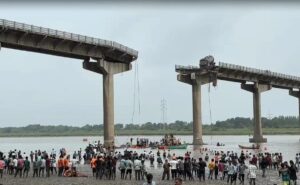Table of Contents
Context: Karnataka State government said that it is ready to resolve river water-sharing disputes between neighbouring States through mutual dialogue rather than intervention of the tribunals/courts.
Introduction
- The Inter-State River Water Disputes are one of the most contentious issues in the Indian federalism today.
- There have been several inter-state river water disputes in India. Most of these disputes arise because of lack of adequate water resources for farmers in the states.
- What makes such disputes complicated is the fact that water resources are under the State List, while the Parliament has the power to make laws regarding inter-state rivers under the Union List.
Reasons for The Existence of Several Inter-State River Water Disputes in India
- Water Scarcity: India is a water-stressed country with uneven distribution of water resources. As a result, states with limited water resources often engage in disputes to secure their fair share.
- For example, the states of Karnataka and Tamil Nadu have been involved in a long-standing dispute over the sharing of Cauvery River water due to water scarcity in the region.
- Competing Water Demands: Different states have competing demands for water, including agricultural irrigation, and industrial use, leading to conflicts as states vie for their respective requirements.
- For instance, the Krishna River dispute between Karnataka and Andhra Pradesh is centered around the allocation of water for irrigation and drinking purposes.
- Historical Agreements and Treaties: Many inter-state water disputes have their roots in historical agreements and treaties that were formulated during the colonial period or post-independence.
- An example is the Ravi-Beas river dispute between Punjab and Haryana, which arose due to the construction of dams and canals after the reorganization of states in 1966.
- Infrastructure Development: The construction of dams, barrages, and irrigation projects on rivers can impact the flow of water downstream, leading to disputes over water allocation.
- Mahanadi River dispute between Odisha and Chhattisgarh is an example where the construction of dams by Chhattisgarh has resulted in reduced water flow to Odisha.
- Political Considerations: Water disputes in India are often influenced by political factors, including regional aspirations, electoral considerations, and states’ perception of their rights over water resources.
- The sharing of Krishna River water between Karnataka and Maharashtra has witnessed political considerations and protests from various stakeholders.
Mechanism for Inter-State River Water Disputes Resolution
| Constitutional provisions |
|
| Laws enacted by the parliament under Article 262 |
|
About Inter-State River Water Dispute Tribunals
- Inter-state river water tribunals are quasi-judicial bodies established by the Indian government, constituted under the Interstate River Water Disputes Act, 1956.
- The primary purpose of these tribunals is to adjudicate and provide a binding decision on the allocation of water resources among the disputing states.
- Composition: The Tribunal shall consist of a Chairman and two other members nominated in this behalf by the Chief Justice of India from among persons who at the time of such nomination are Judges of the Supreme Court or of a High Court.
- The Central Government may, in consultation with the Tribunal, appoint two or more persons as assessors to advise the Tribunal in the proceedings before it.
- Dispute redressal mechanism:
- Once a dispute is referred to a tribunal, it conducts hearings, examines evidence, receives representations from the disputing states, and seeks expert opinions to arrive at a decision.
- The tribunal’s decision, known as an award, is final and binding on all parties involved. The award is published in the Gazette of India and is enforceable under the law.
- However, the decisions of these tribunals can be challenged in the Supreme Court of India through a Special Leave Petition under Article 136 of the Constitution.
- Additionally, the Supreme Court can also intervene if there are issues related to the violation of fundamental rights.
Issues and challenges associated with Interstate Water Dispute Tribunals
- Protracted Proceedings and Delays: One of the primary concerns with these tribunals is the prolonged duration of the dispute resolution process. Cases can often take several years, or even decades, to reach a final resolution. This delay hampers timely decision-making and exacerbates the disputes, as parties involved are left waiting for a resolution.
- Opacity in Institutional Framework: The lack of transparency and clear guidelines governing the proceedings of these tribunals is a significant issue. The lack of clarity in the institutional framework and guidelines leads to confusion and ambiguity in the dispute resolution process.
- Limited Multidisciplinary Composition: The composition of these tribunals typically consists only of members from the judiciary. The absence of experts from other relevant fields, such as hydrology, engineering, and environmental science, limits the ability of the tribunals to comprehensively address technical aspects related to water allocation and management.
- Lack of Authoritative Water Data: The absence of a standardized and authoritative data set makes it difficult to establish a baseline for water allocation and leads to disputes over water availability and utilization.
- Shift from Deliberative to Adversarial Approach: There has been a shift in the approach of these tribunals from a deliberative process to an adversarial one. This shift has led to increased litigation and politicization of water-sharing disputes.
- Nexus Between Water and Politics: Water disputes have increasingly become entangled in political considerations, leading to vote bank politics and further complicating the resolution process.


 Commission for Air Quality Management (C...
Commission for Air Quality Management (C...
 Gujarat Bridge Collapse: 9 Dead as Gambh...
Gujarat Bridge Collapse: 9 Dead as Gambh...
 Phone-tapping in India, Legal Framework ...
Phone-tapping in India, Legal Framework ...





















